Summary of committee site visits related to
the inquiry
This appendix contains summaries of the committee's visits
to the Bennett Brook Disability Justice Centre (WA), the Darwin Correctional
Precinct (NT) and the Alice Springs Correctional Centre (NT).
Site visit to the Bennett Brook Disability Justice Centre
Introduction
Following the committee's public hearing in Perth on 19
September 2016, the committee travelled to the Bennett Brook Disability Justice
Centre (DJC) in the Swan region of Perth to conduct a site visit. The committee
was welcomed to the DJC and provided with a tour by Ms Myra Parry, Manager of
Disability Justice Services and staff of the DJC. Senators Siewert, Duniam,
Pratt and Dodson participated in the site visit.
Until late last year, one of the reasons that people subject
to forensic orders were being indefinitely detained in WA prisons was the lack
of a 'declared place' or a DJC—a secure alternative to prison where therapeutic
and other support services can be provided. This has now been partially
rectified with the construction of the state's first declared place, a ten bed
facility. The DJC is operated by the WA Disability Services Commission (DSC).
Description of the facility
This purpose-built secure facility consists of a ring of
buildings built around a central courtyard with paths, basketball court,
vegetables gardens and shared social spaces including a firepit. The buildings
surrounding this area consist of:
-
apartments where the residents live,
-
a common amenities area with kitchen, laundry, lounge room, games
facilities and computers;
-
a workshop with woodworking tools; and
-
an administrative area with observation rooms, meeting rooms,
medical rooms and staff offices.
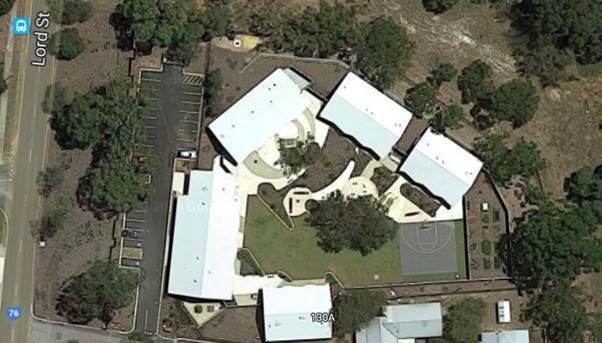
Figure 1.1: An aerial view of the
DJC at Caversham showing the buildings situated around a central courtyard
Placements in the facility
Placements in the DJC are limited to people with cognitive
impairments subject to custody or forensic orders. Placement can only be
recommended by the Mentally Impaired Accused Review Board (MIARB). Residents
are selected on the basis that they will be suitable to transition to live in
the community. Similarly, any leave of absence or separation from the DJC can
only be approved by the MIARB.
Support provided in the DJC and pathways to the community
DJC staff and external private service providers support
residents to live independent, positive and purposeful lives in the centre and
in the community on leave of absence. Leaves of absence are an opportunity for
residents to spend extended periods of time living in the community. Residents
are transitioned to independently live and manage their own home (e.g. cooking
meals, washing, cleaning) and engage in social activities with positive friends
and acquaintances. A staged and supported transition back to the community
ensures that this transition to the community is sustainable for that
individual in the longer term.
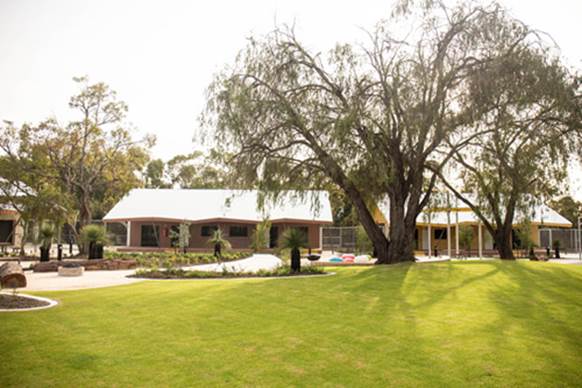
Figure 1.2: View across the central
courtyard area to the administrative and activities buildings within the DJC
Progress so far
Since the DJC's opening late last year, two residents have
successfully transitioned back into the community; two residents currently live
in the DJC; and three prospective residents are being considered for placement.
In evidence to the committee, the DSC suggested that the centre will be close
to full capacity by the end of this year. During the tour, committee members
were able to meet with two current residents. DJC staff noted that there had
been a vast improvement in the social interactions and functioning of the
residents since moving to live in the DJC.
Acknowledgements
On behalf of the committee, Senator Siewert thanked the
residents and staff of the DJC and the WA Disability Services Commission for
warmly hosting the committee's visit.
Site visit to the Darwin Correctional
Precinct
Introduction
Following the committee's public hearing in Darwin on 25
October 2016, the committee travelled to the Darwin Correctional Precinct (DCP)
south of Darwin to conduct a site visit of the Complex Behaviour Unit (CBU) and
the Step-Down Cottages. These facilities were recently opened in September
2015.
The committee were welcomed to the DCP and provided with a
briefing and tour by Mr Bill Carroll (Superintendent-DCP) and staff of the
DCP. The committee were also welcomed to the step-down cottages by Mr Michael
Pearce and residents of the cottages. The committee were provided with a short
briefing and tour of the facility.
Senators Siewert, Duniam, Polley and McCarthy participated
in the site visit.
At the time of the visit, there were thirteen people on
custodial supervision orders (forensic orders) housed in the CBU, with four
people having been transitioned to the step-down cottages.
Complex Behaviour Unit
The CBU currently accommodates male and female offenders placed
on a custodial supervision order or prisoners with severe disabilities. A range
of therapeutic treatment options, life skills, rehabilitation and recreational
options which are tailored to individual needs are provided in the CBU with the
aim of providing a transition pathway to supported living in the community. The
facility provides a range of low, medium and high dependency male and female
accommodation, although the low security part of this centre is not able to be staffed
at this time due to a lack of dedicated funding.[1]
Staff at the CBU provide reports to the Supreme Court for a person's annual
review. Staff will also develop and implement transition and treatment plans
for people subject to custodial supervision orders in the CBU.
The CBU is housed in a corrections environment (different to
the WA Bennett Brook Disability Justice Centre which is operated by the WA
Disability Services Commission) and is operated by the NT Department of
Corrections with support from the NT Department of Health. The CBU is led by a
Clinical Manager as opposed to a corrections officer to ensure the that the CBU
is primarily focused on therapeutic outcomes rather than feeling like a jail. A
Senior Corrections Officer and a number of Corrections Officers support the
Clinical Manager and a range of professional medical and disability staff to
operate the CBU. These Corrections Officers have volunteered to work in the
CBU, and seek to fulfil a wide range of disability support services in addition
to their standard corrective officer duties. DCP described a 'partnership
between Corrective Officers and professional staff'. DCP also acknowledged that
the CBU is still only new and developing new operating procedures and
continually working to improve and optimise performance of the CBU.
Transition to the Step-Down Cottages
Transition to the 'step-down' cottages from the CBU is an
option for those who demonstrate improved behaviour in accordance with their
treatment and transition plan and whom are also deemed a low risk to the
community. The Step-Down Cottages are operated by the Department of Health
(Office of Disability).
The step-down cottages are located on the grounds of the
DCP; however sit outside the DCP wall. The cottages are centred around a
courtyard with an administrative building with includes communal areas, kitchen
and laundry; a three bedroom residence for new residents and those requiring
extra support to reside with staff; and three individual units. There is
capacity for six residents with four currently living there. The objective of
the step-down cottages is to provide a supported accommodation model that
allows a person to learn or re-establish a range of life skills before
potentially being transitioned into the community into a supported living
arrangement.
Acknowledgements
On behalf of the committee, Senator Siewert thanked the
residents and staff of the CBU and the step-down cottages for warmly hosting
the committee's visit.
Site visit to the Alice Springs
Correctional Centre
Introduction
The morning after its Alice Springs public hearing on 27
October 2016, the committee travelled to the Alice Springs Correctional Centre
(ASCC), 20 minutes' drive south-west of Alice Springs. The committee were
welcomed to the ASCC and provided with a briefing and tour by Mr Stephen Rosier
(Superintendent-ASCC) and staff of the ASCC. The committee was provided with a
short briefing and tour of the facility.
At the conclusion of this visit, the committee drove to the
Secure Care Facility (SCF), a facility operated by the Department of Health
(Office of Disability). The SCF operates as a supported and secure step-down
facility which supports people who have transitioned from the ASCC on custodial
supervision orders. The committee were welcomed by Mr David Bosanko (Senior
Clinician—Forensic Mental Health Service (Office of Disability)), and staff and
residents of the SCF. The committee were provided with a short briefing and
tour of the facility.
At the time of the visit, there were two people on custodial
supervision orders (forensic orders) housed in the ASCC in G Block (John Bens
Unit). G Block is a section of the ASCC repurposed to house people on custodial
supervision orders.
Seven people are currently being supported by the SCF. Six
of those people live permanently in the SCF after being transitioned from the
ASCC. One of the people living in G-Block visits the SCF three to five times a
week on day trips as part of his transition plan. Four of the people living in
the SCF are being prepared to transition into supported accommodation in the
community.
Senators Siewert, Duniam, Polley and McCarthy participated
in the site visit.
Alice Springs Correctional Centre – G Block (John Bens Unit)
The John Bens Unit (Unit) is a repurposed part of the
maximum security wing (G-block) of the ASCC, designed to cater for people on
custodial supervision orders. The Unit is sectioned off from the rest of the
maximum security prisoners as a means to protect vulnerable people on custodial
supervision orders from bullying and being taken advantage of. ASCC works with
the Office of Disability to provide reports for annual reviews of any custodial
supervision order to the Supreme Court.
People placed in the Unit are provided with a transition and
treatment plan developed and coordinated by ASCC in conjunction with the Office
of Disability, the Adult Guardian and medical professionals. This report may be
commented on by the Supreme Court at the annual review; however, the
development and on-going review of these plans can commence prior to the review
and continue to occur over the rest of the year without input or oversight by
the Supreme Court. Typically, these plans will have five stages whereby a
person is progressively given greater freedoms, introduced to the SCF (a few
hours then expanding to day trips) and a gradual removal of correctional
officer in the presence of positive behaviours. ASCC and SCF utilise opposing
behavioural approaches and philosophies reflective of the underlying purpose of
each department—ASCC is more disciplinary—"you do this; you lose
that"; whereas the SCF focuses on rewards—"you can have whatever you
want if you display good behaviour". ASCC noted the vast improvement in
specific individual's behaviour with this approach, with a noticeable decrease
in violent behaviour, and improved impulse control and understanding of
consequences that flow from actions. An example of positive behavioural change
is that if good behaviour is displayed when travelling to and from day visits
at the SCF, then this will result in future visits to the SCF. Positive
behaviour results in progression through the stages and can ultimately result
in complete transfer to the SCF from the ASCC; likewise regressive behaviour
results in demotion through the stages within the plan.
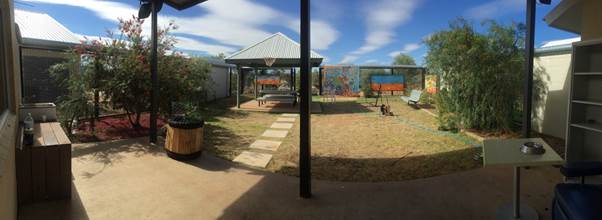
Figure 1.1: A view of an outside
courtyard within the SCF
Transition to the Secure Care Facility
The Secure Care Facility (SCF) is located adjacent to the
ASCC and is operated by the Office of Disability. The SCF provides secure,
supported accommodation for people subject to custodial supervision orders. As
noted previously, transition to the SCF commences once a person has a
transition and treatment plan in place. Subject to certain criteria being met,
primarily management of violent behaviours, a person may commence being
introduced to the SCF. Depending on the level of cognitive functioning, the
starting point for transition may range from a person being shown photos of the
facility and told a story about it to spending a few hours in the SCF, then
extending to day trips. Transition is conducted at a pace commensurate with the
person's capacity to process changes in their physical and social environment.
Subject to the transition process being successful, a person could be expected
to move into and live in the SCF. It is expected that people can, over time,
then be expected to move into and live in supported accommodation in the
community.
Despite being a secure facility, the SCF is a home-like
environment, with televisions, computer access, communal areas (outdoor and
indoor), kitchen and private individual rooms. Access to vehicles and the
capacity to undertake chaperoned community visits is provided on a daily basis.
Freedom of movement is generally not constrained. Disability Support Workers
(DSW) provide day-to-day support in the SCF at a ratio of two workers to one
patient. DSW work closely with patients to meet the objectives of their plans;
whilst access to medical professionals is also provided. Mr Bosanko noted that
when patients have transitioned back to the community, oftentimes, DSWs have
volunteered to transfer to support the person in the community.
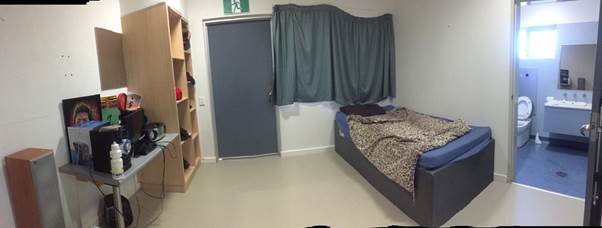
Figure 1.2: A typical room and
ensuite bathroom within the SCF
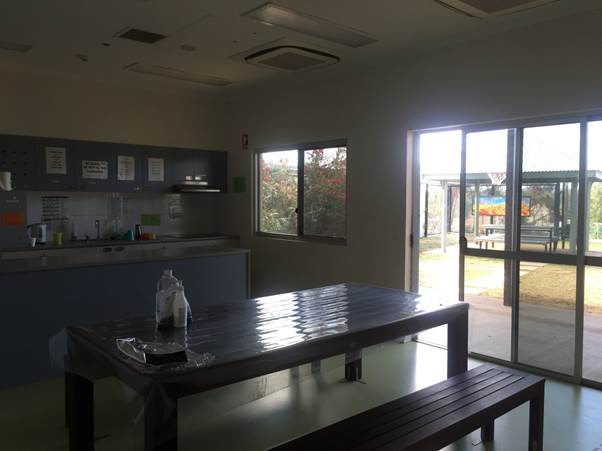
Figure 1.3: The communal kitchen
within the SCF
Acknowledgements
On behalf of the committee, Senator Siewert thanked the
residents and staff of both the ASCC and the SCF for warmly hosting the
committee's visit.
Navigation: Previous Page | Contents